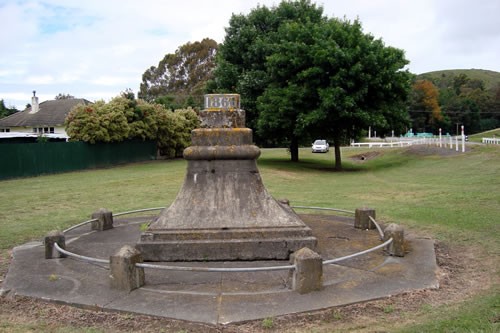
This memorial is located beside the Napier–Taupo Road (State Highway 5) about 15 km north-west of Napier. Standing between the road and the railway line next to Shaw Road, it commemorates the Pētane ambush of 12 October 1866.
The Pai Mārire movement arrived on the east coast of the North Island in 1865. In Hawke’s Bay it found strong support within Ngāti Hineuru, an inland iwi with its principal settlements (kaingā) at Te Hāroto and Tarawera on the present Napier–Taupo Road (State Highway 5).
In early October 1866, Ngāti Hineuru chief Te Rangihiroa and the Pai Mārire prophet Panapa led 80 men in an ‘advance’ on Napier. This party occupied Ōmarunui.
(Ōmarunui was on the south bank of the Tūtaekuri River, about 10km south-west of Napier. On the morning of 12 October – the same morning as the ambush at Pētane (now Bay View) – the poorly fortified kaingā was surrounded and fired upon by a combined force of European militia and Ngāti Kahungunu.)
A party of 25 Ngāti Hineuru men on horseback led by Te Rangihiroa and Pāora Toki subsequently made for Pētane, probably with the intention of reinforcing their kinfolk at Ōmarunui. On the morning of 12 October, they were seen advancing down the Esk (Waiohinganga) Valley.
Concerned about the possibility of an attack on Napier from the north, Colonel George Whitmore had despatched Major James Fraser and 40 Wairoa-based Hawke’s Bay Military Setters to Pētane at 2 a.m. They were reinforced by Captain Oswald Carr and some armed settlers.
In mid-morning movement was spotted 800 m up the valley. An ambush was hastily prepared around a clearing just below a small gorge. The Ngāti Hineuru party was taken by surprise, and in the firing that followed an initial call for surrender, 12 – including Te Rangihiroa – were killed and one wounded. The only European casualty was Sergeant James Fletcher, who was shot in the knee.
Three Ngāti Hineuru were taken prisoner at Pētane and later exiled to the Chatham Islands alongside prisoners taken at Ōmarunui. From there they escaped with Te Kooti Arikirangi Te Turuki on 4 July 1868. Several Ngāti Hineuru, including Nikora, Petera Kahuroa and Te Rangitahau – were among Te Kooti’s most loyal lieutenants.
Among the Ngāti Hineuru who escaped from Pētane were Toki and Ānaru Mātete. Mātete joined Te Kooti in 1868 and fought with him during the guerrilla campaign that followed (1868–72).
In March 1916, 30 ‘enthusiastic’ Ōmarunui veterans met in Napier’s Athenaeum building to discuss ‘means and ways’ of commemorating the engagement. After some discussion, the meeting agreed to hold an anniversary picnic at Ōmarunui and erect a memorial there on land that already been donated by W. Kinross White. ‘A similar arrangement’ would commemorate the Pētane ambush; T. Clark was to be asked to donate land for a memorial there. A committee was formed to meet descendants of the chiefs of the ‘friendly natives’ to discuss the arrangements.
The Pētane memorial was funded partly with money left over from the Ōmarunui one. It was unveiled ‘before a large gathering of veterans and other interested people’ in April 1917, possibly on Anzac Day. Like its counterpart it was deliberately damaged in the early 1990s and is now a mere remnant of the original, which apparently bore the inscription:
To commemorate the fighting at Petane, October 12, 1866, between military settlers and volunteer settlers of this district against the Hauhaus; erected October, 1916.
Additional images
Further information
- ‘Fight at Omaranui – Twenty Three Hau-Haus Killed’, Colonist, 19 October 1866
- ‘Further Particulars’, Colonist, 19 October 1866
- ‘Another Engagement – Twelve Rebels Killed’, Colonist, 19 October 1866
- ‘Meeting of War Veterans’, Colonist, 24 March 1916
- ‘News of the Day’, Colonist, 27 April 1917
- John Battersby, The one day war: the battle of Omarunui, 1866, Reed Books, Auckland, 2000
- James Cowan, ‘The Fight at Omarunui’, in The New Zealand Wars: a history of the Maori campaigns and the pioneering period: Volume II: the Hauhau Wars, 1864–72, R.E. Owen, Wellington, 1956, pp. 137–42
- Thomas Lambert, The story of old Wairoa and the East Coast district, North Island New Zealand, Coulls, Somerville, Wilkie, Dunedin, 1925 (reprinted with index by Reed, Auckland, 1998), pp. 600–3
- Chris Maclean and Jock Phillips, The sorrow and the pride: New Zealand war memorials, GP Books, Wellington, 1990, p. 29
- Nigel Prickett, ‘The East Coast, 1865–66’, in Landscapes of conflict: a field guide to the New Zealand Wars, Random House, Auckland, 2002, pp. 125–31



Community contributions